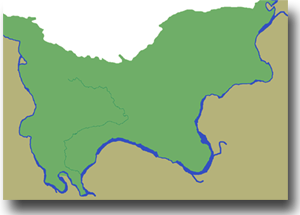
Southern Swamp - How Did We Get This?
The Rock
The upper Cache River drains a portion of the Shawnee Hills. The area is hilly with many rock outcroppings. The rock is sandstone, deposited about 350 million years ago during the Mississippian period, when shallow seas covered Illinois.The Topography
The collision of continental plates uplifted the Shawnee Hills, which lies along a plate wrinkle. Much of the hilly topography was carved by erosion and downcutting of rivers and streams. This area was not flattened by glaciers. At its greatest extent, the Illinois glacier stopped about 45 kilometers (28 mi.) north of here.
The Slough
Little Black Slough is the remnant of a glacial-age lake. During the Wisconsin glaciation, the ice was far to the north. Even so, huge amounts of meltwater flowed down the ancient Ohio River filling the river valley with glacial silt, sand, and gravel. The Cache River backed up near present-day Karnak, to form a lake. Sediment washed down from the surrounding hills AND filled the lake bottom.
As the lake receded, the river began flowing again. It took a crooked, changing course that was often blocked by debris. The riverbed overflowed its banks often, filling the swamps and sloughs in its floodplains.